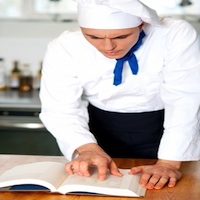Just because you know how to cook does this mean that you are cooking your foods properly--at the right temperatures? Are you putting your family at risk? Contrary to what many of us were taught growing up, there are requirements for properly cooking foods, especially when it comes to cooking meat, as well as requirements for properly handling, reheating, and storing cooked foods! Most foods that are purchased have cooking instructions that include the temperature at which the food must be cooked to avoid bacteria. However, most people do not heed that advice... including me! It wasn’t until I started my company, Rhonda’s Cooking, that I learned there that poultry and beef had to be cooked at certain temperatures in order to prevent food poisoning or foodborne illness like salmonella, E. Coli, etc. 
A couple of years ago, several people had Salmonella poisoning after eating frozen stuffed chicken entrees that were raw but breaded. Allegedly, this salmonella outbreak occurred because those who got sick did not follow the instructions and reportedly used microwaves to prepare the entrees.1
If you’re like me, you probably had no idea that handling and cooking food was this deep! Growing up my mom didn’t have a thermometer to check to see if the meat was done! She taught me how to test for doneness by inserting a knife into the thickest part of the meat or in the center, and if the juice came out clear, then it was considered as done! Even though this worked, there were times that I did under cook the meat especially whenever I had larger pieces of meat that were non-uniform and had a bone. In this case having a thermometer would have allowed me to have better accuracy when testing for doneness.
So, even though you have the cooking skills nailed and have become a pro, it’s better to be safe than sorry when cooking and reheating foods! The following table identifies the minimum cooking temperatures that one should follow when cooking meat dishes:
| Food Items | Min. Internal Cooking Temperatures(degrees) |
|---|---|
| Shell Eggs | 145 |
| Pork/Fish | 145 |
| Beef/Steak/Veal & Lamb | 145 |
| Ground Meat | 155 |
| Poultry (inc. ground)/ Stuffed Meat | 165 |
| Leftovers | 165 |
Note: Anything cooked in temperatures between 41 degrees and 135 degrees is a risk because in these temperature ranges, bacteria grows rapidly and could cause one to get food poisoning. This temperature range is considered the “Danger Zone.”
1“Cook frozen chicken entrees properly, USDA urges.” Reuters.com. 04 Oct. 2008. 05 Oct. 2008
<http://www.reuters.com/article/topNews/idUSTRE4930BJ20081004>.
Image courtesy of StockImages / FreeDigitalPhotos.net








Comments
Comments